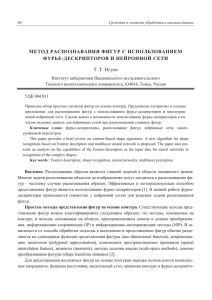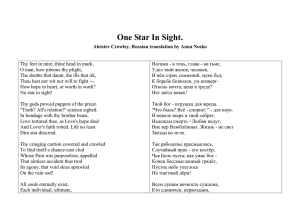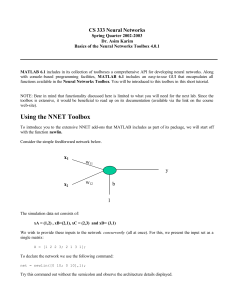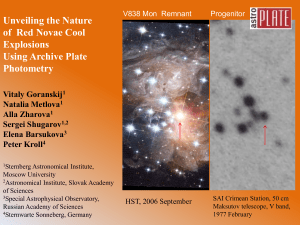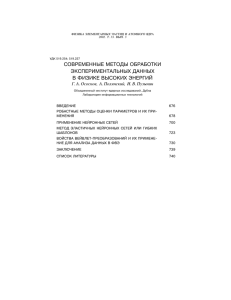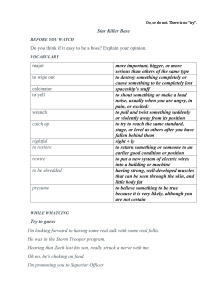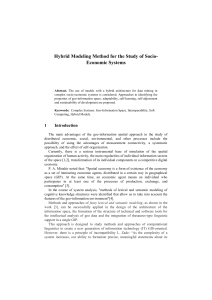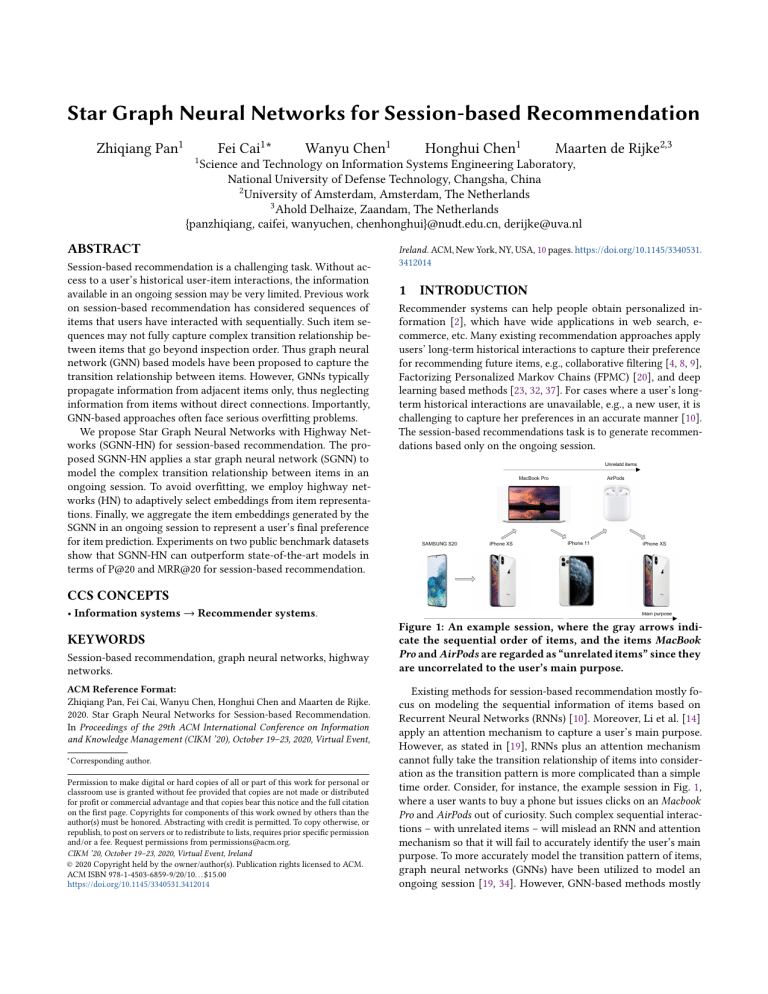
Star Graph Neural Networks for Session-based Recommendation
Zhiqiang Pan1
Fei Cai1 *
1 Science
Wanyu Chen1
Honghui Chen1
Maarten de Rijke2,3
and Technology on Information Systems Engineering Laboratory,
National University of Defense Technology, Changsha, China
2 University of Amsterdam, Amsterdam, The Netherlands
3 Ahold Delhaize, Zaandam, The Netherlands
{panzhiqiang, caifei, wanyuchen, chenhonghui}@nudt.edu.cn, [email protected]
ABSTRACT
Session-based recommendation is a challenging task. Without access to a user’s historical user-item interactions, the information
available in an ongoing session may be very limited. Previous work
on session-based recommendation has considered sequences of
items that users have interacted with sequentially. Such item sequences may not fully capture complex transition relationship between items that go beyond inspection order. Thus graph neural
network (GNN) based models have been proposed to capture the
transition relationship between items. However, GNNs typically
propagate information from adjacent items only, thus neglecting
information from items without direct connections. Importantly,
GNN-based approaches often face serious overfitting problems.
We propose Star Graph Neural Networks with Highway Networks (SGNN-HN) for session-based recommendation. The proposed SGNN-HN applies a star graph neural network (SGNN) to
model the complex transition relationship between items in an
ongoing session. To avoid overfitting, we employ highway networks (HN) to adaptively select embeddings from item representations. Finally, we aggregate the item embeddings generated by the
SGNN in an ongoing session to represent a user’s final preference
for item prediction. Experiments on two public benchmark datasets
show that SGNN-HN can outperform state-of-the-art models in
terms of P@20 and MRR@20 for session-based recommendation.
Ireland. ACM, New York, NY, USA, 10 pages. https://doi.org/10.1145/3340531.
3412014
1
INTRODUCTION
Recommender systems can help people obtain personalized information [2], which have wide applications in web search, ecommerce, etc. Many existing recommendation approaches apply
users’ long-term historical interactions to capture their preference
for recommending future items, e.g., collaborative filtering [4, 8, 9],
Factorizing Personalized Markov Chains (FPMC) [20], and deep
learning based methods [23, 32, 37]. For cases where a user’s longterm historical interactions are unavailable, e.g., a new user, it is
challenging to capture her preferences in an accurate manner [10].
The session-based recommendations task is to generate recommendations based only on the ongoing session.
Unrelatd items
MacBook Pro
SAMSUNG S20
iPhone XS
AirPods
iPhone 11
iPhone XS
CCS CONCEPTS
• Information systems → Recommender systems.
KEYWORDS
Session-based recommendation, graph neural networks, highway
networks.
ACM Reference Format:
Zhiqiang Pan, Fei Cai, Wanyu Chen, Honghui Chen and Maarten de Rijke.
2020. Star Graph Neural Networks for Session-based Recommendation.
In Proceedings of the 29th ACM International Conference on Information
and Knowledge Management (CIKM ’20), October 19–23, 2020, Virtual Event,
∗ Corresponding
author.
Permission to make digital or hard copies of all or part of this work for personal or
classroom use is granted without fee provided that copies are not made or distributed
for profit or commercial advantage and that copies bear this notice and the full citation
on the first page. Copyrights for components of this work owned by others than the
author(s) must be honored. Abstracting with credit is permitted. To copy otherwise, or
republish, to post on servers or to redistribute to lists, requires prior specific permission
and/or a fee. Request permissions from [email protected].
CIKM ’20, October 19–23, 2020, Virtual Event, Ireland
© 2020 Copyright held by the owner/author(s). Publication rights licensed to ACM.
ACM ISBN 978-1-4503-6859-9/20/10. . . $15.00
https://doi.org/10.1145/3340531.3412014
Main purpose
Figure 1: An example session, where the gray arrows indicate the sequential order of items, and the items MacBook
Pro and AirPods are regarded as “unrelated items” since they
are uncorrelated to the user’s main purpose.
Existing methods for session-based recommendation mostly focus on modeling the sequential information of items based on
Recurrent Neural Networks (RNNs) [10]. Moreover, Li et al. [14]
apply an attention mechanism to capture a user’s main purpose.
However, as stated in [19], RNNs plus an attention mechanism
cannot fully take the transition relationship of items into consideration as the transition pattern is more complicated than a simple
time order. Consider, for instance, the example session in Fig. 1,
where a user wants to buy a phone but issues clicks on an Macbook
Pro and AirPods out of curiosity. Such complex sequential interactions – with unrelated items – will mislead an RNN and attention
mechanism so that it will fail to accurately identify the user’s main
purpose. To more accurately model the transition pattern of items,
graph neural networks (GNNs) have been utilized to model an
ongoing session [19, 34]. However, GNN-based methods mostly
propagate information between adjacent items, thus neglecting
information from items without direct connections. Multi-layer
GNNs have subsequently been employed to propagate information
between items without direct connections; however, they easily
lead to overfitting as multiple authors have pointed out [19, 34].
To address the above issues, we propose Star Graph Neural Networks with Highway Networks (SGNN-HN) for session-based recommendation. We first use a star graph neural network (SGNN)
to model the complex transition pattern in an ongoing session,
which can solve the long-range information propagation problem
by adding a star node to take the non-adjacent items into consideration on the basis of gated graph neural networks. Then, to
circumvent the overfitting problem of GNNs, we apply a highway
networks (HN) to dynamically select the item embeddings before
and after SGNN, which can help to explore complex transition relationship between items. Finally, we attentively aggregate item
embeddings generated by the SGNN in an ongoing session so as to
represent user’s preference for making item recommendation.
We conduct experiments on two publicly available benchmark
datasets, i.e., Yoochoose and Diginetica. Our experimental results
show that the proposed SGNN-HN model can outperform state-ofthe-art baselines in terms of P@20 and MRR@20.
In summary, our contributions in this paper are as follows:
(1) To the best of our knowledge, we are the first to consider longdistance relations between items in a session for information
propagation in graph neural networks for session-based recommendation.
(2) We propose a star graph neural network (SGNN) to model the
complex transition relationship between items in an ongoing
session and apply a highway networks (HN) to deal with the
overfitting problem existing in GNNs.
(3) We compare the performance of SGNN-HN against the stateof-the-art baselines on two public benchmark datasets and the
results show the superiority of SGNN-HN over the state-of-theart models in terms of P@20 and MRR@20.
2
RELATED WORK
We review related work from four angles: general recommendation models, sequential recommendation models, attention-based
models, and GNN-based models.
2.1
General recommendation models
Collaborative Filtering (CF) has been widely applied in recommender systems to capture user’s general preferences according
to their historical interactions with items [9]. Many CF methods
consider the user-item interaction matrix based on Matrix Factorization (MF) [39]. In recent years, neural network based methods
have been applied to CF. For instance, He et al. [8] propose Neural
Collaborative Filtering (NCF), which utilizes a multi-layer perceptron to express and generalize matrix factorization in a non-linear
way. Chen et al. [4] propose a Joint Neural Collaborative Filtering
(J-NCF) to learn deep features of users and items by fully exploring
the user-item interactions. Some neighborhood-based CF models
have been proposed to concentrate on the similarity among users
or items. For instance, Item-KNN [22] has been utilized in sessionbased recommendation by focusing on the similarity among items
in terms of co-occurrences in other sessions [5].
Importantly, even though collaborative filtering-based methods can capture a user’s general preferences, it is unable to detect
changes in user interest; as a consequence, they cannot generate
recommendations that instantly adapt to a user’s recent needs.
2.2
Sequential recommendation models
To capture the sequential signal in interactions, Markov Chains
(MCs) have been widely applied. For instance, Rendle et al. [20]
propose Factorizing Personalized Markov Chains (FPMC) to capture
both user’s sequential behaviors and long-term interest. Wang
et al. [31] propose a Hierarchical Representation Model (HRM)
to improve the performance of FPMC by a hierarchical architecture
to non-linearly combine the user vector and the sequential signal.
Deep learning methods like RNNs have also been widely applied
in recommender systems. For instance, Hidasi et al. [10] propose
GRU4REC to apply GRUs in session-based recommendation; they
utilize a session-parallel minibatch for training. Li et al. [14] propose
a Neural Attentive Recommendation Machine (NARM) to extend
GRU4REC by using an attention mechanism to capture user’s main
purpose. Furthermore, as information contained in an ongoing
session may be very limited, neighbor information is introduced to
help model an ongoing session [11, 17, 30]. For instance, Jannach
and Ludewig [11] introduce neighbor sessions with a K-nearest
neighbor method (KNN). Unlike traditional KNN, Wang et al. [30]
propose a Collaborative Session-based Recommendation Machine
(CSRM) to incorporate neighbor sessions as auxiliary information
via memory networks [25, 33].
However, Markov Chain-based models can only capture information from adjacent transactions, making it hard to adequately
capture interest migration. Moreover, as to RNN-based methods,
interaction patterns tend to be more complex than the simple sequential signal in an ongoing session [19].
2.3
Attention based models
As items in a session have different degrees of importance, many
recommendation methods apply an attention mechanism to distinguish the item importance. For instance, Liu et al. [16] apply an
attention mechanism to obtain a user’s general preference and recent interest relying on the long-term and short-term memories in
the current session, respectively. Moreover, in order to better distinguish the importance of items and avoid potential bias brought by
unrelated items, Pan et al. [18] propose to measure item importance
using an importance extraction module, and consider the global
preference and recent interest to make item prediction. Furthermore, for the cases that a user’s historical interactions are available,
Ying et al. [36] propose a two-layer hierarchical attention network
that takes both user’s long-term and short-term preferences into
consideration. In addition, to account for the influence of items
in a user’s long-term and short-term interactions, Chen et al. [3]
propose to utilize a co-attention mechanism.
However, attention-based methods merely focus on the relative
importance of items in a session, without considering the complex
transition relationship between items in an ongoing session.
2.4
Graph neural networks based models
Recently, because of their ability to model complex relationships
between objects, graph neural networks (GNNs) [12, 15, 28] have
x2
...
Star Graph
Session star graph construction
xS
h
x5
h3f
f
4
h
Star Graph
SGNN´L
u3p
Learning item embeddings on graphs
f
5
zg
u5p
u 7p
Softmax Layer
x4
h 7f
u 2p
User Preference
x 0s
xs
h 2f
...
x7
x3
SGNN-L
x5
x7
SGNN-1
x4
Embedding Layer
x5
x2
Highway Networks
x3
ŷ
zr
Session representation and prediction
Figure 2: The workflow of SGNN-HN.
attracted much interest in the context of recommender systems.
For instance, Song et al. [23] propose to introduce graph attention
networks into social recommendation for modeling both dynamic
user interests and context-dependent social influences. Wang et al.
[32] introduce graph neural networks into collaborative filtering
for making recommendations. In addition, GNNs have been utilized to model the complex transition relationship between items
in session-based recommendation. For instance, Wu et al. [34] propose SR-GNN to apply gated graph neural networks (GGNN) for
modeling the transition relationship among items in the ongoing
session so as to generate accurate session representations. Xu et al.
[35] extend SR-GNN with a self-attention mechanism to obtain
contextualized non-local representations for producing recommendations. Furthermore, Qiu et al. [19] propose a weighted graph
attention network (WGAT) based approach for generating item
representation, which is then aggregated by a Readout function as
user preference for item prediction.
The GNN-based methods listed above propagate information
between adjacent items, failing to take unconnected items into
consideration. Moreover, GNN-based methods for session-based
recommendation tend to overfit easily, thereby limiting the ability
to investigate complex transition relationship.
3
APPROACH
In this section, we first formulate the task of session-based recommendation. Then we detail the SGNN-HN model, which consists of
three main components, i.e., session star graph construction (see
Section 3.1), learning item embeddings on star graphs (see Section 3.2), and generating session representations and predictions
(see Section 3.3).
The workflow of SGNN-HN is plotted in Fig. 2. First, a 𝑑-dimension
embedding x𝑖 ∈ R𝑑 is generated for each unique item 𝑥𝑖 in the session through an embedding layer, and each session is constructed as
a session star graph. Then the nodes (item embeddings) in the graph
are input into the multi-layer star graph neural networks (SGNN).
After that, we combine the item embeddings before and after SGNN
using the highway networks. Finally, the session is represented by
combining a general preference and a recent interest in the session.
After obtaining the session representation, recommendations are
generated by calculating the scores on all candidate items.
The goal of session-based recommendation is to predict the next
item to click based on the ongoing session. We formulate this task
as follows. Let 𝑉 = {𝑣 1, 𝑣 2, . . . , 𝑣 |𝑉 | } denote all unique items in
all sessions, where |𝑉 | is the number of all unique items. Given
a session as 𝑆 = {𝑣 1, 𝑣 2, . . . , 𝑣𝑡 , . . . , 𝑣𝑛 } consisting of 𝑛 sequential
items, where 𝑣𝑡 ∈ 𝑉 is the 𝑡-th item in the session, we aim to
predict 𝑣𝑛+1 to click. Specifically, we output the probability of all
items ŷ = {ŷ1, ŷ2, . . . , ŷ |𝑉 | }, where ŷ𝑖 ∈ ŷ indicates the likelihood
score of clicking item 𝑖. Then, the items with the highest top-K
scores in ŷ will be recommended to the user.
3.1
Session star graph construction
For each session 𝑆 = {𝑣 1, 𝑣 2, . . . , 𝑣𝑡 , . . . , 𝑣𝑛 }, we construct a star
graph to represent the transition relationship among the items in
the session. We not only consider the adjacent clicked items, but
the items without direct connections by adding a star node, which
leads to a full connection of all nodes in the session star graph.
Specifically, each session is then represented as 𝐺𝑠 = {V𝑠 , E𝑠 },
where V𝑠 = {{𝑥 1, 𝑥 2, . . . , 𝑥𝑚 }, 𝑥𝑠 } denotes the node set of the star
graph. Here, the first part {𝑥 1, 𝑥 2, . . . , 𝑥𝑚 } indicates all unique items
in the session, which we call satellite nodes, and the latter part 𝑥𝑠 is
the newly added star node. Note that 𝑚 ≤ 𝑛 since there may exist
repeated items in the session. E𝑠 is the edge set in the star graph,
which consists of two types of edges, i.e., satellite connections and
star connections, used for propagating information from satellite
nodes and star node, respectively.
Satellite connections. We utilize satellite connections to represent
the adjacency relationship between items in a session. Here, we
use the gated graph neural networks (GGNN) [15] as an example.
Actually, other graph neural networks like GAT [28] and GCN [12]
can also be utilized to replace GGNN in our model. For the satellite
connections, the edges (𝑥𝑖 , 𝑥 𝑗 ) ∈ E𝑠 , i.e., the blue solid lines in the
star graphs in Fig. 2, mean that the user clicks item 𝑥 𝑗 after clicking
𝑥𝑖 . In this way, the adjacent relationship between two items in the
session can be represented by an incoming matrix and an outgoing
matrix. Considering an example session 𝑆 = {𝑥 2, 𝑥 3, 𝑥 5, 𝑥 4, 𝑥 5, 𝑥 7 },
we can construct the incoming matrix and the outgoing matrix of
GGNN as in Fig. 3.
Star connections. Inspired by [6], we add a star node to propagate
information from non-adjacent items, More specifically, we add a
x7
x2
x3
x5
Outgoing Matrix
x4
Incoming Matrix
2
3
5
4
7
2
0
0
0
0
0
3
1
0
0
0
0
0 1/2 1/2
5
0 1/2 0 1/2 0
0
1
0
0
4
0
0
1
0
0
0
0
0
0
7
0
0
1
0
0
2
3
5
4
7
2
0
1
0
0
0
3
0
0
1
0
0
5
0
0
4
0
7
0
Satellite nodes update. For each satellite node, the neighbor nodes
for propagating information are from two types of sources, i.e.,
the adjacent nodes and the star node, which corresponds to the
information from nodes with and without direct connections, respectively. Compared to GGNN [15] and GAT [28], the star node
in the proposed SGNN can make information from unconnected
items available for propagation across two hops.
First, we consider the information from adjacent nodes. For each
satellite node 𝑥𝑖 in the star graph at layer 𝑙, we utilize the incoming
and the outgoing matrices to obtain the propagation information
as follows:
𝑙−1
𝑙−1 T 𝐼
𝐼
a𝑙𝑖 = 𝐶𝑜𝑛𝑐𝑎𝑡 (A𝑖𝐼 ([x𝑙−1
1 , x2 , . . . , x𝑚 ] W + b ),
𝑙−1 𝑙−1
𝑙−1 T 𝑂
𝑂
A𝑂
𝑖 ([x1 , x2 , . . . , x𝑚 ] W + b )),
Figure 3: An example of adjacent matrices in GGNN.
bidirectional edge between the star node and each satellite node
in the star graph. On the one hand, we use the directed edges
from the star node to the satellite nodes, i.e., the blue dotted lines
(𝑥𝑠 , 𝑥𝑖 ) ∈ E𝑠 in the star graphs in Fig. 2, for updating the satellite
nodes, where 𝑥𝑖 is a satellite node. Via the star node, information
from non-adjacent nodes can be propagated in a two-hop way by
taking the star node as an intermediate node. On the other hand,
the directed edges from the satellite nodes to the star node, i.e.,
the red dotted lines (𝑥𝑖 , 𝑥𝑠 ) ∈ E𝑠 in the star graphs in Fig. 2, are
used to update the star node, which helps generate an accurate
representation of the star node by considering all nodes in the star
graph.
Unlike the basic graph neural networks, we consider the connection relationship from both the adjacency matrices and the
bidirectional connections introduced by the star node, where the
adjacency matrices are constructed according to the sequential click
order, and a gating network is utilized to dynamically control how
much information should be obtained from the adjacent nodes and
the star node, respectively.
3.2
1×𝑚 are the corresponding incoming and outgowhere A𝑖𝐼 , A𝑂
𝑖 ∈R
ing weights for node 𝑥𝑖 , i.e., the 𝑖-th row in the incoming matrix and
the outgoing matrix. W𝐼 , W𝑂 ∈ R𝑑×𝑑 are the learnable parameters
for the incoming edges and the outgoing edges, respectively, while
b𝐼 , b𝑂 ∈ R𝑑 are the bias vectors. Hence, we can obtain a𝑙𝑖 ∈ R1×2𝑑
to represent the propagation information for node 𝑥𝑖 . After that,
we feed a𝑙𝑖 and node 𝑥𝑖 ’s previous state h𝑙−1
into the gated graph
𝑖
neural networks as follows:
z𝑙𝑖 = 𝜎 (W𝑧 a𝑙𝑖 + U𝑧 h𝑙−1
𝑖 ),
r𝑙𝑖 = 𝜎 (W𝑟 a𝑙𝑖 + U𝑟 h𝑙−1
𝑖 ),
(4)
𝑙
h̃𝑖 = tanh(Wℎ a𝑙𝑖 + Uℎ (r𝑙𝑖 ⊙ h𝑙−1
𝑖 )),
𝑙
ĥ𝑖 = (1 − z𝑙𝑖 ) ⊙ h𝑙−1
+ z𝑙𝑖 ⊙ h̃𝑙 ,
𝑖
where W𝑧 , W𝑟 , Wℎ ∈ R𝑑×2𝑑 and U𝑧 , U𝑟 , Uℎ ∈ R𝑑×𝑑 are trainable
parameters in the network. 𝜎 represents the activation function
𝑠𝑖𝑔𝑚𝑜𝑖𝑑 in above formulas and ⊙ is the element-wise multiplication.
z𝑙𝑖 and r𝑙𝑖 are the update gate and the reset gate, which controls how
much information in the former state h𝑙−1
should be preserved and
𝑖
how much information of the previous state should be written in the
𝑙
Learning item embeddings on graphs
Next, we present how star graph neural networks (SGNN) can
propagate information between the nodes of the graph. In the
SGNN, there are two main stages, i.e., satellite node representing
and star node representing.
3.2.1 Initialization. Before passing the nodes into the SGNN, we
first initialize the representation of satellite nodes and the star node.
For the satellite nodes, we directly take the embeddings of unique
items in the session as the satellite nodes representation:
h0 = {x1, x2, . . . , x𝑚 },
(3)
candidate activation h̃𝑖 , respectively. In this way, information from
adjacent items can be propagated in star graph neural networks.
Next, we consider information from the star node. In star graph
neural networks, the star node can represent the overall information
from all items in a session. For each satellite node, we apply a gating
network to decide how much information should be propagated
from the star node and the adjacent nodes, respectively. Specifically,
we calculate the similarity 𝛼𝑖𝑙 of each satellite node 𝑥𝑖 and the star
node 𝑥𝑠 with a self-attention mechanism as:
𝑙 T
(1)
where x𝑖 ∈ R𝑑 is a 𝑑-dimensional embedding of satellite node 𝑖 in
the star graph. As for the star node, denoted as x𝑠0 , we apply an
average pooling on the satellite nodes to get the initialization of
the star node, i.e.,
𝑚
1 ∑︁
x𝑠0 =
x𝑖 .
(2)
𝑚 𝑖=1
3.2.2 Update. To learn a node representation according to the
graph, we update the satellite nodes and the star node as follows.
𝛼𝑖𝑙 =
(W𝑞1 ĥ𝑖 ) W𝑘1 x𝑙−1
𝑠
,
√
𝑑
(5)
𝑙
where W𝑞1, W𝑘1 ∈ R𝑑×𝑑 are trainable parameters, ĥ𝑖 and x𝑙−1
𝑠 are
the corresponding
item
representation
of
𝑥
and
𝑥
,
respectively,
𝑖
𝑠
√
and 𝑑 is used for scaling the coefficient. Finally, we apply a gating
network to selectively integrate the information from the adjacent
𝑙
node ĥ𝑖 and from the star node x𝑙−1
𝑠 as follows:
𝑙
h𝑙𝑖 = (1 − 𝛼𝑖𝑙 ) ĥ𝑖 + 𝛼𝑖𝑙 x𝑙−1
𝑠 .
(6)
Star node update. For updating the star node based on the new
representation of satellite nodes, we introduce a self-attention mechanism to assign different degrees of importance to the satellite nodes
by regarding the star node as 𝑞𝑢𝑒𝑟𝑦. First, the importance of each
satellite node is determined by the star node:
𝛽 = softmax
T 𝑙 T
𝑙−1
K q
© (W𝑘2 h ) W𝑞2 x𝑠 ª
=
softmax
­
®,
√
√
𝑑
𝑑
«
¬
(7)
Algorithm 1 The procedure of Star Graph Neural Networks
Input: {x1, x2, . . . , x𝑚 }: Initial embeddings of the unique items in
the session
Output: h 𝑓 and x𝑠 : New representation of the satellite nodes and
star node
0
1: h = {x1 , x2 , . . . , x𝑚 }
0
2: x𝑠 = average(x1 , x2 , . . . , x𝑚 )
3: for l in range(L) do
𝑙
4:
ĥ = GGNN (h𝑙−1, A𝐼 , A𝑂 ) based on (3) and (4)
where q ∈ R𝑑 and K ∈ R𝑑×𝑚 are transformed from the star node
and the satellite nodes, respectively. W𝑞2, W𝑘2 ∈ R𝑑×𝑑 are the
corresponding trainable parameters. After obtaining the degrees of
importance, we combine the satellite nodes using a linear combination as a new representation of the star node:
5:
𝛼 𝑙 = Att ( ĥ , x𝑙−1
𝑠 ) based on (5)
(8)
10:
x𝑙𝑠
𝑙
= 𝛽h ,
6:
7:
8:
9:
𝑙
𝑙
𝑙
h𝑙 = Gating( ĥ , x𝑙−1
𝑠 , 𝛼 ) based on (6)
𝑙 ) based on (7) and (8)
x𝑙𝑠 = SelfAtt (x𝑙−1
,
h
𝑠
end for
h 𝑓 = HighwayNetworks(h0, h𝐿 ) based on (10) and (11)
return new satellite nodes h 𝑓 and new star node x𝑠
where 𝛽 ∈ R𝑚 are the weights of all satellite nodes.
3.3
3.2.3 Highway networks. By updating the satellite nodes and the
star node iteratively, we can obtain accurate item representations.
Moreover, in order to accurately represent the transition relationship between items, multi-layer SGNNs can be stacked, where the
𝑙-layer of SGNN can be denoted as:
After generating the item representations based on the star graph
neural networks, we obtain the sequential item embeddings from
the corresponding satellite nodes h 𝑓 ∈ R𝑑×𝑚 as u ∈ R𝑑×𝑛 . In order
to incorporate the sequential information into SGNN-HN, we add
learnable position embeddings p ∈ R𝑑×𝑛 to the item representations, i.e., u𝑝 = u + p.
Then we consider both the global preference and recent interest
within the session to generate a final session representation as
user’s preference. As previous work has shown that the last item in
a session can represent a user’s recent interest [16, 34], we directly
take the representation of the last item as the user’s recent interest,
𝑝
i.e., z𝑟 = u𝑛 . As for the global preference, considering that items
in a session have different degrees of importance, we combine the
items according to their corresponding priority:
𝐼
𝑂
h𝑙 , x𝑙𝑠 = SGNN (h𝑙−1, x𝑙−1
𝑠 , A , A ).
(9)
However, the multi-layer graph layers can propagate large amounts
of information between nodes, which easily brings bias, leading to
overfitting problems with the graph neural networks as stated in
[19, 34]. To address this problem, we apply the highway networks
[24] to selectively obtain information from the item embeddings
before and after the multi-layer SGNNs. As we employ an 𝐿-layer
SGNN, the item embeddings of the satellite nodes before and after
the SGNN layers are denoted as h0 and h𝐿 , respectively. Then, the
highway networks can be denoted as:
h 𝑓 = g ⊙ h0 + (1 − g) ⊙ h𝐿 ,
(10)
where the gating g ∈ R𝑑×𝑚 is decided by the input and output of
multi-layer SGNNs:
0
g = 𝜎 (W𝑔 [h ; h ]),
𝐿
(11)
where [·] is the concatenation operation, W𝑔 ∈ R𝑑×2𝑑 is a trainable
parameter that transforms the concatenated vector from R2𝑑 to
R𝑑 , and 𝜎 is the 𝑠𝑖𝑔𝑚𝑜𝑖𝑑 function. After the highway networks, we
can obtain the final representation of satellite nodes as h 𝑓 , and the
corresponding star node as x𝑠𝐿 (denoted as x𝑠 for brevity).
We detail the proposed procedure of SGNNs in Algorithm 1. We
first initialize the representation of satellite nodes and star node as
step 1 and 2. Then we update the representations through 𝐿-layer
SGNNs using steps 3 to 8, where we update the satellite nodes in
steps 4 to 6 and the star node in step 7 at each SGNN layer. After that,
we utilize the highway networks to combine the item embeddings
before and after the multi-layer SGNNs in step 9. Finally, we return
the new representations of the satellite nodes and the star node.
Session representation and prediction
z𝑔 =
𝑛
∑︁
(12)
𝑝
𝛾𝑖 u𝑖 .
𝑖=1
where the priority 𝛾𝑖 is decided by both the star node x𝑠 and the
current interest z𝑟 simultaneously. Specifically, the weights of items
are decided by a soft attention mechanism:
𝛾𝑖 = W0 T 𝜎 (W1 u𝑖 + W2 x𝑠 + W3 z𝑟 + b),
(13)
𝑝
R𝑑 ,
where W0 ∈
W1 , W2 , W3 ∈
are trainable parameters
to control the weights, and b ∈ R𝑑 is the bias. Then we combine
user’s global preference and her current interest as the final session
representation by concatenating them:
R𝑑×𝑑
zℎ = W4 [z𝑔 ; z𝑟 ],
(14)
where [·] is the concatenation operation and W4 ∈
transforms the concatenated representation from R2𝑑 into R𝑑 .
After obtaining user’s preference, we use it to make recommendations by calculating the probabilities on all candidate items in 𝑉 .
First, to solve the long-tail problem in recommendation [1, 7], we
apply a layer normalization on the session representation zℎ and
the embedding of each candidate item v𝑖 , i.e., z̃ℎ = 𝐿𝑎𝑦𝑒𝑟 𝑁𝑜𝑟𝑚(zℎ )
and ṽ𝑖 = 𝐿𝑎𝑦𝑒𝑟 𝑁𝑜𝑟𝑚(v𝑖 ), respectively. After normalization, we
calculate the scores ỹ of each item in the item set 𝑉 by multiplying
R𝑑×2𝑑
the session representation with all item embeddings as follows:
ỹ𝑖 = z̃ℎT ṽ𝑖 .
(15)
Finally, we apply a softmax layer to normalize the preference scores
of candidate items. It is worth noting that we will face a convergence
problem after normalization as the softmax loss will be trapped at
a very high value on the training set [29]. To address this problem,
a scale coefficient 𝜏 is applied inside the softmax to obtain the final
scores:
exp (𝜏 ỹ𝑖 )
ŷ = Í
, ∀𝑖 = 1, 2, . . . , |𝑉 |,
(16)
𝑖 exp (𝜏 ỹ𝑖 )
where ŷ = ( ŷ1, ŷ2, . . . , ŷ |𝑉 | ). Finally, the items with the highest
scores in ŷ will be recommended to the user.
To train our model, we employ cross-entropy as the optimization
objective to learn the parameters as:
𝐿( ŷ) = −
|𝑉 |
∑︁
y𝑖 log( ŷ𝑖 ) + (1 − y𝑖 ) log(1 − ŷ𝑖 ),
(17)
𝑖=1
where y𝑖 ∈ y reflects the appearance of an item in the one-hot
encoding vector of the ground truth, i.e., y𝑖 = 1 if the 𝑖-th item is
the target item of the given session; otherwise, y𝑖 = 0. In addition,
we apply the Back-Propagation Through Time (BPTT) algorithm
[21] to train the SGNN-HN model.
4 EXPERIMENTS
4.1 Research questions
To examine the performance of SGNN-HN, we address four research
questions:
(RQ1) Can the proposed SGNN-HN model beat the competitive
baselines for the session-based recommendation task?
(RQ2) What is the contribution of the star graph neural networks
(SGNN) to the overall recommendation performance?
(RQ3) Can the highway networks alleviate the overfitting problem
of graph neural networks?
(RQ4) How does SGNN-HN perform on sessions with different
lengths compared to the baselines?
4.2
Datasets
We evaluate the performance of SGNN-HN and the baselines on two
publicly available benchmark datasets, i.e., Yoochoose and Diginetica.
• Yoochoose1 is a public dataset released by the RecSys Challenge
2015, which contains click streams from an e-commerce website
within a 6 month period.
• Diginetica2 is obtained from the CIKM Cup 2016. Here we only
adopt the transaction data.
For Yoochoose, following [14, 16, 34], we filter out sessions of length
1 and items that appear less than 5 times. Then we split the sessions for training and test, respectively, where the sessions of the
last day is used for test and the remaining part is regarded as the
training set. Furthermore, we remove items that are not included
in the training set. As for Diginetica, the only difference is that we
utilize the sessions of the last week for test. After preprocessing,
7,981,580 sessions with 37,483 items are remained in the Yoochoose
1 http://2015.recsyschallenge.com/challege.html
2 http://cikm2016.cs.iupui.edu/cikm-cup
Table 1: Statistics of the datasets used in our experiments.
Statistics
Yoochoose 1/64 Yoochoose 1/4 Diginetica
# clicks
# training sessions
# test sessions
# items
Average session length
557,248
369,859
55,898
16,766
6.16
8,326,407
5,917,746
55,898
29,618
5.71
982,961
719,470
60,858
43,097
5.12
dataset, and 204,771 sessions with 43,097 items are remained in the
Diginetica dataset.
Similar to [14, 16, 34], we use a sequence splitting preprocess
to augment the training samples. Specifically, for session 𝑆 =
{𝑣 1, 𝑣 2, . . . , 𝑣𝑛 }, we generate the sequences and corresponding labels as ([𝑣 1 ], 𝑣 2 ), ([𝑣 1, 𝑣 2 ], 𝑣 3 ), . . . , ([𝑣 1, . . . , 𝑣𝑛−1 ], 𝑣𝑛 ) for training
and test. Moreover, as Yoochoose is too large, following [14, 16, 34],
we only utilize the recent 1/64 and 1/4 fractions of the training sequences, denoted as Yoochoose 1/64 and Yoochoose 1/4, respectively.
The statistics of the three datasets, i.e., Yoochoose 1/64, Yoochoose
1/4 and Diginetica are provided in Table 1.
4.3
Model summary
The models discussed in this paper are the following: (1) Two traditional methods, i.e., S-POP [2] and FPMC [20]; (2) Three RNN-based
methods, i.e., GRU4REC [10], NARM [14] and CSRM [30]; (3) Two
attention-based methods, i.e., STAMP [16] and SR-IEM [18]; and
(4) Two GNN-based methods, i.e., SR-GNN [34] and NISER+ [7].
• S-POP recommends the most popular items for the current session.
• FPMC is a state-of-the-art hybrid method for sequential recommendation based on Markov Chains. We omit the user representation since it is unavailable in session-based recommendation.
• GRU4REC applies GRUs to model the sequential information
in session-based recommendation and adopts a session-parallel
mini-batch training process.
• NARM employs GRUs to model the sequential behavior and
utilizes an attention mechanism to capture user’s main purpose.
• CSRM extends NARM by introducing neighbor sessions as auxiliary information for modeling the current session with a parallel
memory module.
• STAMP utilizes an attention mechanism to obtain the general
preference and resorts to the last item as recent interest in current
session to make prediction.
• SR-IEM employs a modified self-attention mechanism to estimate the item importance and makes recommendations based
on the global preference and current interest.
• SR-GNN utilizes the gated graph neural networks to obtain
item embeddings and make recommendations using an attention
mechanism to generate the session representation.
• NISER+ introduces L2 normalization to solve the long-tail problem and applies dropout to alleviate the overfitting problem of
SR-GNN.
4.4
Experimental setup
We implement SGNN-HN with six layers of SGNNs to obtain the
item embeddings. The hyper parameters are selected on the validation set which is randomly selected from the training set with a
proportion of 10%. Following [7, 18, 34], the batch size is set to 100
and the dimension of item embeddings is 256. We adopt the Adam
optimizer with an initial learning rate 1𝑒 −3 and a decay factor 0.1
for every 3 epochs. Moreover, L2 regularization is set to 1𝑒 −5 to
avoid overfitting, and the scale coefficient 𝜏 is set to 12 on three
datasets. All parameters are initialized using a Gaussian distribution
with a mean of 0 and a standard deviation of 0.1.
Table 2: Model performance. The results of the best performing baseline and the best performer in each column are underlined and boldfaced, respectively. ▲ denotes a significant
improvement of SGNN-HN over the best baseline using a
paired 𝑡-test (p < 0.01).
4.5
S-POP
FPMC
Evaluation metrics
Following previous works [14, 34], we adopt P@K and MRR@K
to evaluate the recommendation performance.
P@K (Precision): The P@K score measures whether the target item is included in the top-K recommendations of the list of
recommended items.
𝑛
P@K = ℎ𝑖𝑡 ,
(18)
𝑁
where 𝑁 is the number of test sequences in the dataset and 𝑛ℎ𝑖𝑡 is
the number of cases that the target item is in the top-K items of the
ranked list.
MRR@K (Mean Reciprocal Rank): The MRR@K score considers
the position of the target item in the list of recommended items. It
is set to 0 if the target item is not in the top-K of ranking list, and
otherwise is calculated as follows:
∑︁
1
1
,
(19)
MRR@K =
𝑁
𝑅𝑎𝑛𝑘 (𝑣𝑡𝑎𝑟𝑔𝑒𝑡 )
𝑣𝑡𝑎𝑟𝑔𝑒𝑡 ∈𝑆𝑡𝑒𝑠𝑡
where 𝑣𝑡𝑎𝑟𝑔𝑒𝑡 is the target item and 𝑅𝑎𝑛𝑘 (𝑣𝑡𝑎𝑟𝑔𝑒𝑡 ) is the position
of the target item in the list of recommended items. Compared to
P@K, MRR@K is a normalized hit which takes the position of the
target item into consideration.
5 RESULTS AND DISCUSSION
5.1 Overall performance
We present the results of the proposed session-based recommendation model SGNN-HN as well as the baselines in Table 2. For
the baselines we can observe that the neural methods generally
outperform the traditional baselines, i.e., S-POP and FPMC. The
neural methods can be split into three categories:
RNN-based neural baselines. As for the RNN-based methods,
we can see that NARM generally performs better than GRU4REC,
which validates the effectiveness of emphasizing the user’s main
purpose. Moreover, comparing CSRM to NARM, by incorporating
neighbor sessions as auxiliary information for representing the
current session, CSRM outperforms NARM for all cases on three
datasets, which means that neighbor sessions with similar intent
to the current session can help boost the recommendation performance.
Attention-based neural baselines. As for the attention-based methods, STAMP and SR-IEM, we see that SR-IEM generally achieves a
better performance than STAMP, where STAMP employs a combination of the mixture of all items and the last item as “query” in
the attention mechanism while SR-IEM extracts the importance
of each item individually by comparing each item to other items.
Thus, SR-IEM can avoid the bias introduced by the unrelated items
and make accurate recommendations.
Method
Yoochoose 1/64
Yoochoose 1/4
Diginetica
P@20 MRR@20 P@20 MRR@20 P@20 MRR@20
30.44
45.62
18.35
15.01
27.08
-
17.75
-
21.06
31.55
13.68
8.92
GRU4REC 60.64
NARM
68.32
CSRM
69.85
22.89
28.63
29.71
59.53
69.73
70.63
22.60
29.23
29.48
29.45
49.70
51.69
8.33
16.17
16.92
STAMP
SR-IEM
68.74
71.15
29.67
31.71
70.44
71.67
30.00
31.82
45.64
52.35
14.32
17.64
SR-GNN
NISER+
70.57
71.27
30.94
31.61
71.36
71.80
31.89
31.80
50.73
53.39
17.59
18.72
SGNN-HN 72.06▲ 32.61▲ 72.85▲ 32.55▲ 55.67▲ 19.45▲
GNN-based neural baselines. Considering the GNN-based methods, i.e., SR-GNN and NISER+, we can observe that the best performer NISER+ can generally outperform the RNN-based and attention-based methods for most cases on the three datasets, which
verifies the effectiveness of graph neural networks on modeling the
transition relationship of items in the session. In addition, NISER+
can outperform SR-GNN for most cases on the three datasets except
for Yoochoose 1/4, where NISER+ loses against SR-GNN in terms of
MRR@20. This may be due to the fact that the long-tail problem
and the overfitting problem become more prevalent in scenarios
with relatively few training data.
In later experiments, we take the best performer in each category
of the neural methods for comparison, i.e., CSRM, SR-IEM and
NISER+.
Next, we move to the proposed model SGNN-HN. From Table 2,
we observe that SGNN-HN can achieve the best performance in
terms of P@20 and MRR@20 for all cases on the three datasets.
The improvement of the SGNN-HN model against the baselines
mainly comes from two aspects. One is the proposed star graph
neural network (SGNN). By introducing a star node as the transition
node of every two items in the session, SGNN can help propagate
information not only from adjacent items but also items without
direct connections. Thus, each node can obtain abundant information from their neighbor nodes. The other one is that by using the
highway networks to solve the overfitting problem, our SGNN-HN
model can stack more layers of star graph neural networks, leading
to a better representation of items.
Moreover, we find that the improvement of SGNN-HN over the
best baseline in terms of P@20 and MRR@20 on Yoochoose 1/64 are
1.11% and 2.84%, respectively, and 1.46% and 2.07% on Yoochoose 1/4.
The relative improvement in terms of MRR@20 is more obvious
than that of P@20 on both Yoochoose 1/64 and Yoochoose1/4. In
contrast, a higher improvement in terms of P@20 than of MRR@20
is observed on Diginetica, returning 4.27% and 3.90%, respectively.
This may be due to the fact that the number of candidate items
are different on Yoochoose and Diginetica, where the number of
72.1
32.5
71.8
32.0
71.5
71.2
Utility of star graph neural networks
SAT-HN
GGNN-HN
SGNN-HN
66
60
54
48
42
SAT-HN
GGNN-HN
SGNN-HN
32
MRR@20 (%)
P@20 (%)
72
28
24
20
16
Yoochoose 1/64
Yoochoose 1/4
Datasets
(a) P@20.
Diginetica
12
Yoochoose 1/64
Yoochoose 1/4
Diginetica
Datasets
(b) MRR@20.
Figure 4: Performance comparison to assess the utility of
star graph neural networks.
1
2
3
4
The number of GNN layers
5
31.0
30.0
6
72.9
32.6
72.6
32.2
72.3
72.0
NISER+
SGNN-SR
SGNN-HN
71.7
71.4
1
2
3
4
The number of GNN layers
5
30.6
6
MRR@20 (%)
18.8
52.5
51.0
NISER+
SGNN-SR
SGNN-HN
3
4
5
(e) P@20 on Diginetica.
5
6
NISER+
SGNN-SR
SGNN-HN
1
2
3
4
The number of GNN layers
5
6
18.2
17.6
NISER+
SGNN-SR
SGNN-HN
17.0
The number of GNN layers
4
(d) MRR@20 on Yoochoose 1/4.
19.4
2
3
The number of GNN layers
31.4
54.0
1
2
31.8
55.5
48.0
1
31.0
(c) P@20 on Yoochoose 1/4.
49.5
NISER+
SGNN-SR
SGNN-HN
(b) MRR@20 on Yoochoose 1/64.
MRR@20 (%)
P@20 (%)
31.5
30.5
(a) P@20 on Yoochoose 1/64.
P@20 (%)
In order to answer RQ2, we compare the star graph neural networks
(SGNN) in our proposal with a gated graph neural network (GGNN)
[15] and a self-attention mechanism (SAT) [27]. On the one hand,
GGNN can only propagate information from the adjacent nodes
while neglecting nodes without direct connections. Correspondingly, we only need to update the satellite nodes at each SGNN layer.
In other words, the SGNN will be simplified to GGNN. On the other
hand, SAT can be regarded as a full-connection graph that each
node can obtain information from all nodes in the graph. In particular, if we remove the GGNN part from the SGNN, set the number of
star nodes as the number of items in the session and then replace
Eq. (2) by an identity function, i.e., x𝑠 = {x1, x2, . . . , x𝑛 }, where
x𝑠 ∈ R𝑑×𝑛 , then the SGNN will become a self-attention mechanism.
Generally, SGNN can be regarded as a dynamic combination of
GGNN and SAT.
To prove the effectiveness of SGNN, we substitute the SGNN
in our proposal with two alternatives for propagating information
between items and evaluate the performance in terms of P@20 and
MRR@20 on three datasets. The variants are denoted as: (1) GGNN-HN, which replaces the SGNN with a simple GGNN; (2) SAT-HN,
which replaces SGNN with GAT. See Figure 4.
In Figure 4, we see that SGNN-HN can achieve the best performance in terms of both P@20 and MRR@20 on three datasets.
Moreover, as for the variants, GGNN-HN performs better than GATHN for all cases on the three datasets. We attribute this to the fact
that the self-attention mechanism propagates information from
all items in a session, which will bring a bias of unrelated items.
However, the GNN-based methods, i.e., GGNN-HN and SGNN-HN,
can both explore the complex transition relationship between items
via GNNs to avoid the bias brought by the unrelated items, thus
a better performance is achieved than GAT-HN. Moreover, comparing GGNN-HN to SGNN-HN, we see that GGNN-HN can only
propagate information from adjacent items, missing much information from unconnected items and leading to a worse performance
than SGNN-HN.
NISER+
SGNN-SR
SGNN-HN
70.9
70.6
5.2
MRR@20 (%)
P@20 (%)
candidate items in Yoochoose 1/64 and Yoochoose 1/4 are obviously
less than that of the Diginetica dataset.
Our results indicate that our proposed SGNN-HN model can help
put the target item at an earlier position when there are relatively
few candidate items and is more effective on hitting the target item
in the recommendation list for cases with relatively many candidate
items.
6
16.4
1
2
3
4
The number of GNN layers
5
6
(f) MRR@20 on Diginetica.
Figure 5: Model performance of different number of GNN
layers.
5.3
Utility of highway networks
For RQ3, in order to investigate the impact of the number of GNN
layers on the proposed SGNN-HN model and to validate the effectiveness of the highway networks, we compare SGNN-HN to
its variant SGNN-SR, which removes the highway networks from
SGNN-HN. In addition, the comparison involves the best performer
in the category of GNN-based methods, i.e., NISER+. Specifically,
we increase the number of GNN layers from 1 to 6, to show the
performance in terms of P@20 and MRR@20 of NISER+, SGNN-SR
and SGNN-HN on three datasets. The results are shown in Figure 5.
As shown in Figure 5, SGNN-HN achieves the best performance
in terms of both P@20 and MRR@20 for almost all cases on three
datasets. For P@20, from Figure 5a, 5c and 5e, we can observe that
as the number of GNN layers increases, the performance of both
SGNN-SR and NISER+ drops rapidly on the three datasets. Graph
neural networks for session-based recommendation face a serious
overfitting problem. Moreover, SGNN-SR outperforms NISER+ for
all cases on the three datasets, which indicates that the proposed
SGNN has a better ability than GGNN to represent the transition
relationship between items in a session. As to the proposed SGNNHN model, as the number of layers increases, we can see that the
performance in terms of P@20 decreases slightly on Yoochoose 1/64
as well as Yoochoose 1/4 and remains relatively stable on Diginetica.
5.4
Impact of the session length
To answer RQ4, we evaluate the performance of SGNN-HN and the
state-of-the-art baselines, i.e., CSRM, SR-IEM and NISER+ on three
datasets. Following [16, 34], we separate the sessions according
to their length, i.e., the number of clicked items. Specifically, the
sessions containing less than or equal to 5 clicked items are regarded
as “Short”, while others are deemed as “Long”. We set the threshold
to 5 as in [16, 34] since it is the closest integer to the average
length of sessions in three datasets. The ratios of “Short” and “Long”
sessions for test for the Yoochoose 1/64 and Yoochoose 1/4 datasets
are 70.10% and 29.90%, respectively, and 76.40% and 23.60% for
Diginetica. The performance in terms of P@20 and MRR@20 of
SGNN-HN and the baselines are shown in Figure 6.
From Figure 6, we see that SGNN-HN can achieve the best performance in terms of P@20 and MRR@20 for all cases on the three
datasets. Moreover, as the session length increases, the performance
of all models in terms of both P@20 and MRR@20 on the three
datasets consistently decreases, which may be due to the fact that
longer sessions are more likely to contain unrelated items, making it
harder to correctly identify the user preference. For P@20, as shown
in Figure 6a, 6c and 6e, we see that among the baselines, CSRM
performs worst for both “Short” and “Long” sessions on the three
datasets, validating that the transition relationship in the session is
more complicated than a simple sequential signal. By comparing
SR-IEM and NISER+, we can observe that their performance are
similar for the “Short” sessions, while NISER+ shows an obvious
CSRM
SR-IEM
NISER+
SGNN-HN
73
69
67
65
63
CSRM
SR-IEM
NISER+
SGNN-HN
34.5
MRR@20 (%)
P@20 (%)
71
32.0
29.5
27.0
24.5
Short
22.0
Long
Short
Session length
69
67
CSRM
SR-IEM
NISER+
SGNN-HN
34.5
MRR@20 (%)
71
P@20 (%)
(b) MRR@20 on Yoochoose 1/64.
CSRM
SR-IEM
NISER+
SGNN-HN
73
65
63
32.0
29.5
27.0
24.5
Short
22.0
Long
Short
Session length
Long
Session length
(c) P@20 on Yoochoose 1/4.
(d) MRR@20 on Yoochoose 1/4.
CSRM
SR-IEM
NISER+
SGNN-HN
55
51
49
47
CSRM
SR-IEM
NISER+
SGNN-HN
19.5
MRR@20 (%)
53
45
Long
Session length
(a) P@20 on Yoochoose 1/64.
P@20 (%)
In addition, as the number of layers goes up, the performance
of SGNN-HN shows a large gap over SGNN-SR and NISER+. By
introducing the highway gating, SGNN-HN can effectively solve
the overfitting problem and avoid the rapid decrease in terms of
P@20 when the number of GNN layers increases.
For MRR@20, we can observe that as the number of layers increases, SGNN-SR shows a similar decreasing tread on the three
datasets. However, the performance of NISER+ goes down on Yoochoose 1/64 and Diginetica while it increases on Yoochoose 1/4. In
addition, NISER+ shows a better performance than SGNN-SR with
relatively more GNN layers. Unlike SGNN-SR, we can observe that
SGNN-HN achieves the best performance for most cases on the
three datasets. Moreover, with the number of layers increasing,
the performance of SGNN-HN increases consistently, which may
be due to the fact that the highway networks in SGNN-HN can
adaptively select the embeddings of item representations before
and after the multi-layer SGNNs. Furthermore, comparing SGNNHN to SGNN-SR, we can see that the improvement brought by the
highway networks is more obvious when incorporating more GNN
layers. This could be due to the fact that with the highway networks,
more SGNN layers can be stacked, thus more information about
the transition relationship between items can be obtained.
Moreover, comparing the effect of the highway networks on
P@20 and MRR@20 in our SGNN-HN model, we can observe that
the highway networks can improve the MRR@20 scores as the
number of GNN layers increases while maintaining a stable P@20
score. This could be due to the fact that SGNN-HN is able to focus
on the important items so that it can push the target item at an
earlier position by using the highway networks.
18.0
16.5
15.0
13.5
Short
Long
Session length
(e) P@20 on Diginetica.
12.0
Short
Long
Session length
(f) MRR@20 on Diginetica.
Figure 6: Model performance on short and long sessions.
better performance for the “Long” sessions. This indicates that by
modeling the complex transition relationship between items, GNNs
can accurately obtain user’s preference to hit the target item when
user-item interactions are relatively many.
As for MRR@20, NISER+ does not show better performance
than SR-IEM on both “Short” and “Long” sessions on Yoochoose
1/64, and the same phenomenon is observed on Yoochoose 1/4. However, SGNN-HN clearly outperforms SR-IEM for all cases on the
three datasets. We attribute the difference in performance between
NISER+ and SGNN-HN to: (1) the SGNN makes the information
from long-range items available in information propagating; and
(2) the highway networks in SGNN-HN allow for the complex transition relationship between items to be investigated more accurately
through multi-layer SGNNs, which can boost the ranking of the
target item in the list of recommended items.
In addition, in terms of P@20, the improvements of SGNN-HN
against the best baseline NISER+ for “Short” and “Long” sessions
are 1.18% and 0.79% on Yoochoose 1/64, respectively; 4.96% and
4.67% improvements of SGNN-HN over NISER+ on Diginetica are
observed. This indicates that SGNN-HN is more effective at hitting
the target item for relatively short sessions. Moreover, in terms of
MRR@20, the improvements of SGNN-HN against the best baselines
NISER+ and SR-IEM for “Short” and “Long” sessions are 1.23% and
2.97% on Yoochoose 1/64, respectively. Here higher improvement is
observed on “Long” sessions. Differently on Diginetica, 4.62% and
3.76% improvements of SGNN-HN against NISER+ are observed on
“Short” and “Long” sessions, respectively. The difference in terms of
MRR@20 between the two datasets may be due to the fact that the
average session length are different; it is bigger in Yoochoose 1/64
than in Diginetica. As there are proportionally more long sessions
in Yoochoose 1/64, this explains the bigger improvement on “Long”
than “Short” sessions for Yoochoose 1/64.
6
CONCLUSIONS AND FUTURE WORK
In this paper, we propose a novel approach, i.e., Star Graph Neural
Networks with Highway Networks (SGNN-HN), for session-based
recommendation. SGNN-HN applies star graph neural networks
(SGNN) to model the complex transition relationship between items
in a session to generate accurate item embeddings. Moreover, to
deal with the overfitting problem of graph neural networks in
session-based recommendation, we utilize highway networks to
dynamically combine information from item embeddings before
and after multi-layer SGNNs. Finally, we apply an attention mechanism to combine item embeddings in a session as the user’s general
preference, which is then concatenated with her recent interest
expressed by her last clicked item in the session for making item
recommendation. Experiments conducted on two public benchmark datasets show that SGNN-HN can significantly improve the
recommendation performance in terms of P@20 and MRR@20.
As to future work, on the one hand, we would like to incorporate neighbor sessions to enrich the transition relationship in the
current session like in [11, 30]. On the other hand, we are interested in applying star graph neural networks to other tasks like
conversational recommendation [13, 26] and dialogue systems [38]
to investigate its scalability.
ACKNOWLEDGMENTS
This work was partially supported by the National Natural Science
Foundation of China under No. 61702526, the Defense Industrial
Technology Development Program under No. JCKY2017204B064,
and the Postgraduate Scientific Research Innovation Project of
Hunan Province under No. CX20200055. All content represents the
opinion of the authors, which is not necessarily shared or endorsed
by their respective employers and/or sponsors.
REFERENCES
[1] Himan Abdollahpouri, Robin Burke, and Bamshad Mobasher. 2017. Controlling
Popularity Bias in Learning-to-Rank Recommendation. In RecSys’17. 42–46.
[2] Gediminas Adomavicius and Alexander Tuzhilin. 2005. Toward the Next Generation of Recommender Systems: A Survey of the State-of-the-Art and Possible
Extensions. IEEE Trans. Knowl. Data Eng. 17, 6 (2005), 734–749.
[3] Wanyu Chen, Fei Cai, Honghui Chen, and Maarten de Rijke. 2019. A Dynamic
Co-attention Network for Session-based Recommendation. In CIKM’19. 1461–
1470.
[4] Wanyu Chen, Fei Cai, Honghui Chen, and Maarten de Rijke. 2019. Joint Neural
Collaborative Filtering for Recommender Systems. ACM Trans. Inf. Syst. 37, 4
(2019), 39:1–39:30.
[5] Diksha Garg, Priyanka Gupta, Pankaj Malhotra, Lovekesh Vig, and Gautam M.
Shroff. 2019. Sequence and Time Aware Neighborhood for Session-based Recommendations: STAN. In SIGIR’19. 1069–1072.
[6] Qipeng Guo, Xipeng Qiu, Pengfei Liu, Yunfan Shao, Xiangyang Xue, and Zheng
Zhang. 2019. Star-Transformer. In NAACL’19. 1315–1325.
[7] Priyanka Gupta, Diksha Garg, Pankaj Malhotra, Lovekesh Vig, and Gautam M.
Shroff. 2019. NISER: Normalized Item and Session Representations with Graph
Neural Networks. arXiv preprint arXiv:1909.04276 (2019).
[8] Xiangnan He, Lizi Liao, Hanwang Zhang, Liqiang Nie, Xia Hu, and Tat-Seng
Chua. 2017. Neural Collaborative Filtering. In WWW’17. 173–182.
[9] Jonathan L. Herlocker, Joseph A. Konstan, Loren G. Terveen, and John Riedl.
2004. Evaluating collaborative filtering recommender systems. ACM Trans. Inf.
Syst. 22, 1 (2004), 5–53.
[10] Balázs Hidasi, Alexandros Karatzoglou, Linas Baltrunas, and Domonkos Tikk.
2016. Session-based Recommendations with Recurrent Neural Networks. In
ICLR’16.
[11] Dietmar Jannach and Malte Ludewig. 2017. When Recurrent Neural Networks
meet the Neighborhood for Session-Based Recommendation. In RecSys’17. 306–
310.
[12] Thomas N. Kipf and Max Welling. 2017. Semi-Supervised Classification with
Graph Convolutional Networks. In ICLR’17.
[13] Wenqiang Lei, Xiangnan He, Yisong Miao, Qingyun Wu, Richang Hong, Min-Yen
Kan, and Tat-Seng Chua. 2020. Estimation-Action-Reflection: Towards Deep
Interaction Between Conversational and Recommender Systems. In WSDM’20.
304–312.
[14] Jing Li, Pengjie Ren, Zhumin Chen, Zhaochun Ren, Tao Lian, and Jun Ma. 2017.
Neural Attentive Session-based Recommendation. In CIKM’17. 1419–1428.
[15] Yujia Li, Daniel Tarlow, Marc Brockschmidt, and Richard S. Zemel. 2016. Gated
Graph Sequence Neural Networks. In ICLR’16.
[16] Qiao Liu, Yifu Zeng, Refuoe Mokhosi, and Haibin Zhang. 2018. STAMP: ShortTerm Attention/Memory Priority Model for Session-based Recommendation. In
KDD’18. 1831–1839.
[17] Zhiqiang Pan, Fei Cai, Yanxiang Ling, and Maarten de Rijke. 2020. An Intentguided Collaborative Machine for Session-based Recommendation. In SIGIR’20.
1833–1836.
[18] Zhiqiang Pan, Fei Cai, Yanxiang Ling, and Maarten de Rijke. 2020. Rethinking
Item Importance in Session-based Recommendation. In SIGIR’20. 1837–1840.
[19] Ruihong Qiu, Jingjing Li, Zi Huang, and Hongzhi Yin. 2019. Rethinking the
Item Order in Session-based Recommendation with Graph Neural Networks. In
CIKM’19. 579–588.
[20] Steffen Rendle, Christoph Freudenthaler, and Lars Schmidt-Thieme. 2010. Factorizing personalized Markov chains for next-basket recommendation. In WWW’10.
811–820.
[21] David E Rumelhart, Geoffrey E Hinton, and Ronald J Williams. 1986. Learning
representations by back-propagating errors. Nature 323, 6088 (1986), 533–536.
[22] Badrul Munir Sarwar, George Karypis, Joseph A. Konstan, and John Riedl. 2001.
Item-based collaborative filtering recommendation algorithms. In WWW’01. 285–
295.
[23] Weiping Song, Zhiping Xiao, Yifan Wang, Laurent Charlin, Ming Zhang, and Jian
Tang. 2019. Session-Based Social Recommendation via Dynamic Graph Attention
Networks. In WSDM’19. 555–563.
[24] Rupesh Kumar Srivastava, Klaus Greff, and Jürgen Schmidhuber. 2015. Highway
Networks. arXiv preprint arXiv:1505.00387 (2015).
[25] Sainbayar Sukhbaatar, Arthur Szlam, Jason Weston, and Rob Fergus. 2015. EndTo-End Memory Networks. In NeurIPS’15. 2440–2448.
[26] Yueming Sun and Yi Zhang. 2018. Conversational Recommender System. In
SIGIR’18. 235–244.
[27] Ashish Vaswani, Noam Shazeer, Niki Parmar, Jakob Uszkoreit, Llion Jones,
Aidan N. Gomez, Lukasz Kaiser, and Illia Polosukhin. 2017. Attention is All
you Need. In NeurIPS’17. 5998–6008.
[28] Petar Velickovic, Guillem Cucurull, Arantxa Casanova, Adriana Romero, Pietro
Liò, and Yoshua Bengio. 2018. Graph Attention Networks. In ICLR’18.
[29] Feng Wang, Xiang Xiang, Jian Cheng, and Alan Loddon Yuille. 2017. NormFace:
L2 Hypersphere Embedding for Face Verification. In MM’17. 1041–1049.
[30] Meirui Wang, Pengjie Ren, Lei Mei, Zhumin Chen, Jun Ma, and Maarten de Rijke.
2019. A Collaborative Session-based Recommendation Approach with Parallel
Memory Modules. In SIGIR’19. 345–354.
[31] Pengfei Wang, Jiafeng Guo, Yanyan Lan, Jun Xu, Shengxian Wan, and Xueqi
Cheng. 2015. Learning Hierarchical Representation Model for NextBasket Recommendation. In SIGIR’15. 403–412.
[32] Xiang Wang, Xiangnan He, Meng Wang, Fuli Feng, and Tat-Seng Chua. 2019.
Neural Graph Collaborative Filtering. In SIGIR’19. 165–174.
[33] Jason Weston, Sumit Chopra, and Antoine Bordes. 2015. Memory Networks. In
ICLR’15.
[34] Shu Wu, Yuyuan Tang, Yanqiao Zhu, Liang Wang, Xing Xie, and Tieniu Tan.
2019. Session-Based Recommendation with Graph Neural Networks. In AAAI’19.
346–353.
[35] Chengfeng Xu, Pengpeng Zhao, Yanchi Liu, Victor S. Sheng, Jiajie Xu, Fuzhen
Zhuang, Junhua Fang, and Xiaofang Zhou. 2019. Graph Contextualized SelfAttention Network for Session-based Recommendation. In IJCAI’19. 3940–3946.
[36] Haochao Ying, Fuzhen Zhuang, Fuzheng Zhang, Yanchi Liu, Guandong Xu, Xing
Xie, Hui Xiong, and Jian Wu. 2018. Sequential Recommender System based on
Hierarchical Attention Networks. In IJCAI’18. 3926–3932.
[37] Feng Yu, Qiang Liu, Shu Wu, Liang Wang, and Tieniu Tan. 2016. A Dynamic
Recurrent Model for Next Basket Recommendation. In SIGIR’16. 729–732.
[38] Hainan Zhang, Yanyan Lan, Liang Pang, Jiafeng Guo, and Xueqi Cheng. 2019.
ReCoSa: Detecting the Relevant Contexts with Self-Attention for Multi-turn
Dialogue Generation. In ACL’19. 3721–3730.
[39] Shuai Zhang, Lina Yao, Aixin Sun, and Yi Tay. 2019. Deep Learning Based
Recommender System: A Survey and New Perspectives. ACM Comput. Surv. 52,
1 (2019), 5:1–5:38.
